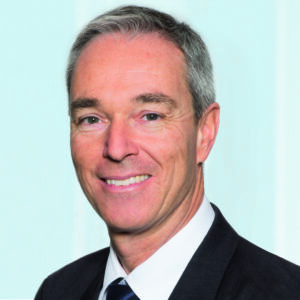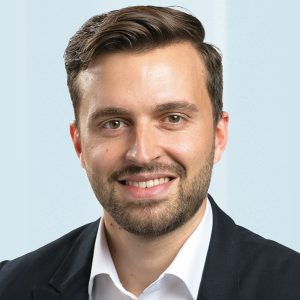
NEXT LEVEL: Sales & Operations Planning
As an integrated business management process, Sales & Operations planning (S&OP) ensures a synchronous and autonomous corporate divisions.
At the North American business unit of elevator manufacturer thyssenkrupp Elevator Victoria Frank and Brian McGovern together with Staufen.Inova have redefined the balance between supply and demand. The two US managers report in an interview what role Scrum played in this.

thyssenkrupp Elevator is characterized by complex supply and production chains. How has S&OP changed these processes?
Victoria Frank: It was not our intention to reduce complexity through S&OP but rather to make it manageable. The path there was defined by transparency and a steady flow of information. As one of the world’s largest elevator manufacturers, we participate in a dynamic market and always produce customized products. It was important to us to create a common denominator for everyone involved in the internal and external production and sales chains. like to compare S&OP to a puzzle piece that links the sales and production departments. S&OP not only helps to align production or launch a new product, but it also shows its strengths in the current situation with the corona pandemic. We are now able to ideally respond to such challenges and at short notice because all communication processes are well established.
Brian McGovern: At thyssenkrupp Elevator, a large number of different parties are involved, all pursuing the same goal: to sell a safe and high-quality product that we can deliver on-time. However, different priorities are set along the way. Sales wants to sell as much as possible, production focuses on supply chains and stock levels, and the branches keep an eye on a smooth installation process and serviceability. Differing and often conflicting perceptions from individual parties also complicate matters. With S&O P, we bring all stakeholders together and align realistic assumptions, thereby creating an environment in which everyone can achieve their KPIs without slowing each other down or preventing them from achieving their KPIs.
For you, S&OP is not like a classic management process, but it is rather based on the agile procedure model Scrum from the field of software development. What advantages does this combination offer?
Victoria Frank: This combination is a very innovative approach, which was introduced by Staufen. Through the Scrum approach, we have established a fixed rhythm of when and how to exchange information and what has to be done by when. Continuous exchange forms the basis for defining goals and implementing them. Everything is embedded in a system that enables continuous improvement. At the same time, it is independent of the people involved. The process does not stop, even if individuals are not available to keep driving forward.
Brian McGovern: The most impressive thing was how the focus shifted more and more from a project management approach to a Scrum approach during the implementation phase. The whole team shifted its focus from analyzing the current situation to a future oriented plan on how best to get from A to B. We initiated an iterative process via Scrum, which is great. Today, Scrum is a way of life for us, a never-ending process. The combination of S&OP and Scrum has established itself as a solid unit and will continue to be followed and consequently improved.
How did changes in the day-to-day, for example, affect the cooperation with suppliers?
Victoria Frank: When we launched our latest product, the “Evolution” series of elevators, we significantly benefited from the S&OP processes. Within only twelve months, we were able to implement customer requests and launch the new product. For such a launch to be successful, numerous stakeholders must work closely together: from sales, production and accounting to internal and external suppliers. Whereas individual departments were largely autonomous and independent of each other in the past, we encouraged interaction and were able to make joint decisions that benefited both our customers and our company. All parties involved improved their planning reliability and were able to generate advantages in efficiency.
Brian McGovern: Timing is challenging in our industry. When our sales team sells an elevator, the construction of the building has not been started yet. It often takes months before the elevator can be installed. Nevertheless, the sales department pushes for rapid production from the very beginning, even if the delivery date is still a long way off. At the same time, production tries to prevent production bottlenecks and therefore keeps many parts in stock so that even the most optimistic forecasts would not cause problems. Since not all expectations could always be fulfilled in the past , other departments sometimes plan far too cautiously. In short: Everyone has their own experience and adapts resources to their own ideas. These truths, each of which is absolutely plausible in itself, are now merged into a “chamber of truth” by means of S&OP. These discussion rounds ensure transparency, realistic forecasts and smooth production processes with optimal stock levels.

What role did
play in the implementation of S&OP and how important is the position of the S&OP manager internally?
Victoria Frank: The support from the Staufen colleagues Thomas Spiess und Lucas Zeugin was extremely helpful. From the very beginning, a vision was communicated of what we wanted to achieve and what results we were aiming for. On the path there, practical help and the necessary theoretical foundation was provided. Numerous best-practice examples helped us implement our S&OP strategy. This is exactly what I want from a consultancy and was also a decisive factor in the successful introduction of S&OP.
Brian McGovern: In the past, we had challenges to sustainably implement far-reaching changes. Staufen quickly recognized that cultural changes were also needed and proposed a necessary course. Even though I myself have been working in the company for 13 years and have gained experience in many different departments, this support made my work as S&OP Manager much easier. In my position, I do not need to be given special powers. Instead, credibility and trust in the organization are the basic requirements for such a cross-functional position.
Please feel free to contact us if you want to get any further information about this topic
THOMAS SPIESS, Senior Partner, STAUFEN.INOVA AG
Moderator with great experience in the cross-cultural environment
Long-standing experience as project manager and senior consultant in Supply Chain Management within the high-tech-, luxury consumer goods industry, textile- and fashion industry
phone: +49 7024 8056 0, e-mail: contact@staufen.ag

LUCAS ZEUGIN, Consultant, STAUFEN.INOVA AG
Several project tasks in supply chain management including sales and operations planning, organization development and optimization of distribution logistics
Deepened knowledge in process optimization as well as simulation and modeling
phone: +49 7024 8056 0, e-mail: contact@staufen.ag

